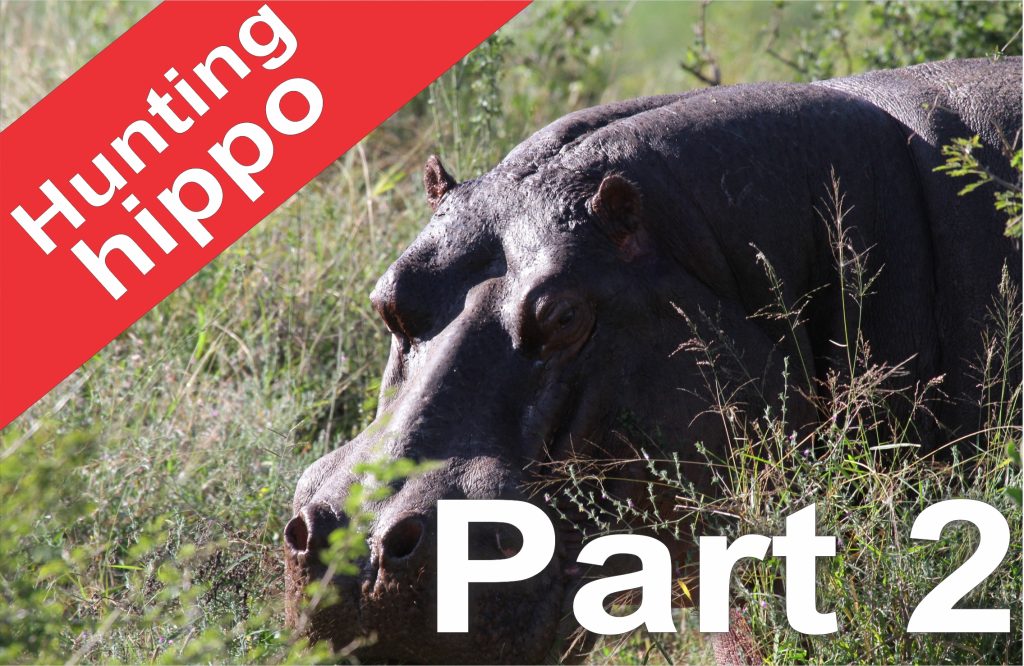The amphibious river horse Hippopotamus amphibious is a worthwhile adversary and potentially highly dangerous (Figure 1). The size of the animal combined with its robust skeleton, thick skin, and heavy muscle make it imperative to use suitable calibres and well-constructed bullets when attempting heart/lung shots at hippos on land especially when it comes to following up wounded hippos. That having been said, they can be relatively easy to kill using the right calibre, bullet, and shot placement; but, they can be decidedly difficult to kill if you have “blown the first shot” with an ill-placed bullet or arrow.
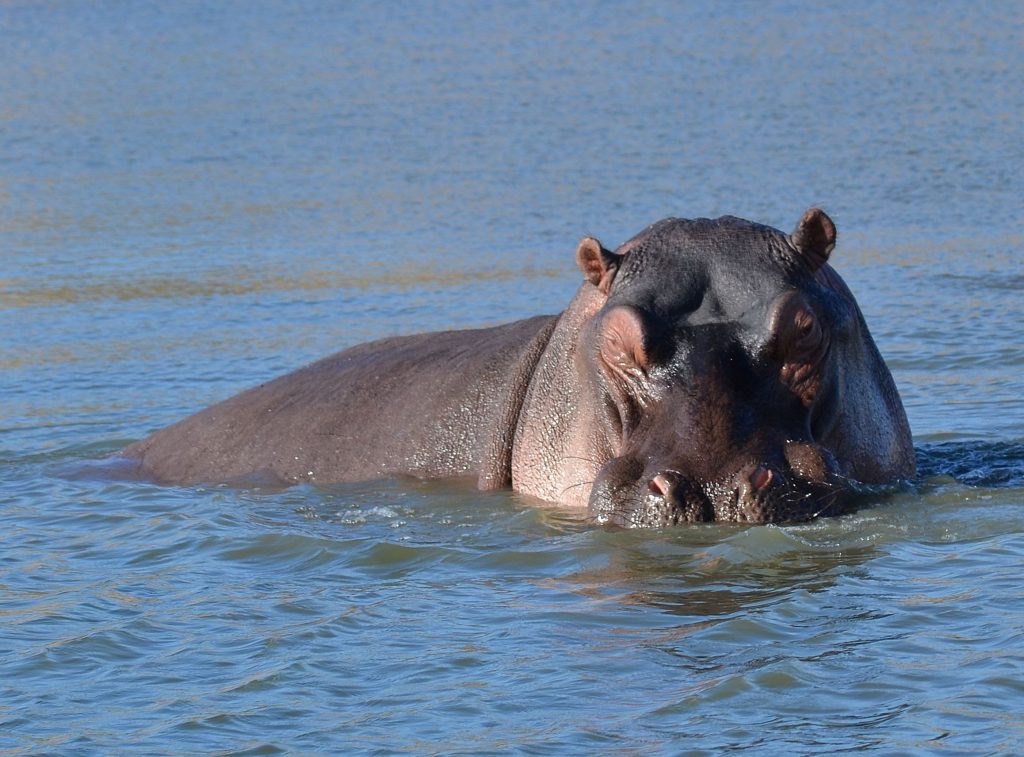
Recommended Equipment
Recommended rifle calibres
Scoped smaller calibers have been used for frontal brain shots on hippos because the target is small and, when shots have to be taken from ranges of 50 to 100 meters or more, it is difficult to place shots accurately at this range using an open-sighted big bore rifle. However, smaller calibers may not meet the legal requirements and should definitely not be used when following up a wounded hippo.
To err on the side of safety and to stay on the right side of the law use a .375 H&H with a low power scope (1-4X magnification) as a minimum. Calibers such as .404 Jeffery, .416 Rigby, one of the 9.3mm’s (.366), or other larger calibers such as .458 Win Mag., .458 Lott, .470 Nitro Express, .500 Nitro Express, .505 Gibbs, or even the fearsome .600 Nitro Express are recommended. See Figure 2.

Recommended bullets for hunting hippo
For brain shots, a monolithic solid or expanding solid will work well (Figure 3). Well-constructed softs or expanding solids are well suited for side-on or quartering away heart/lung shots.
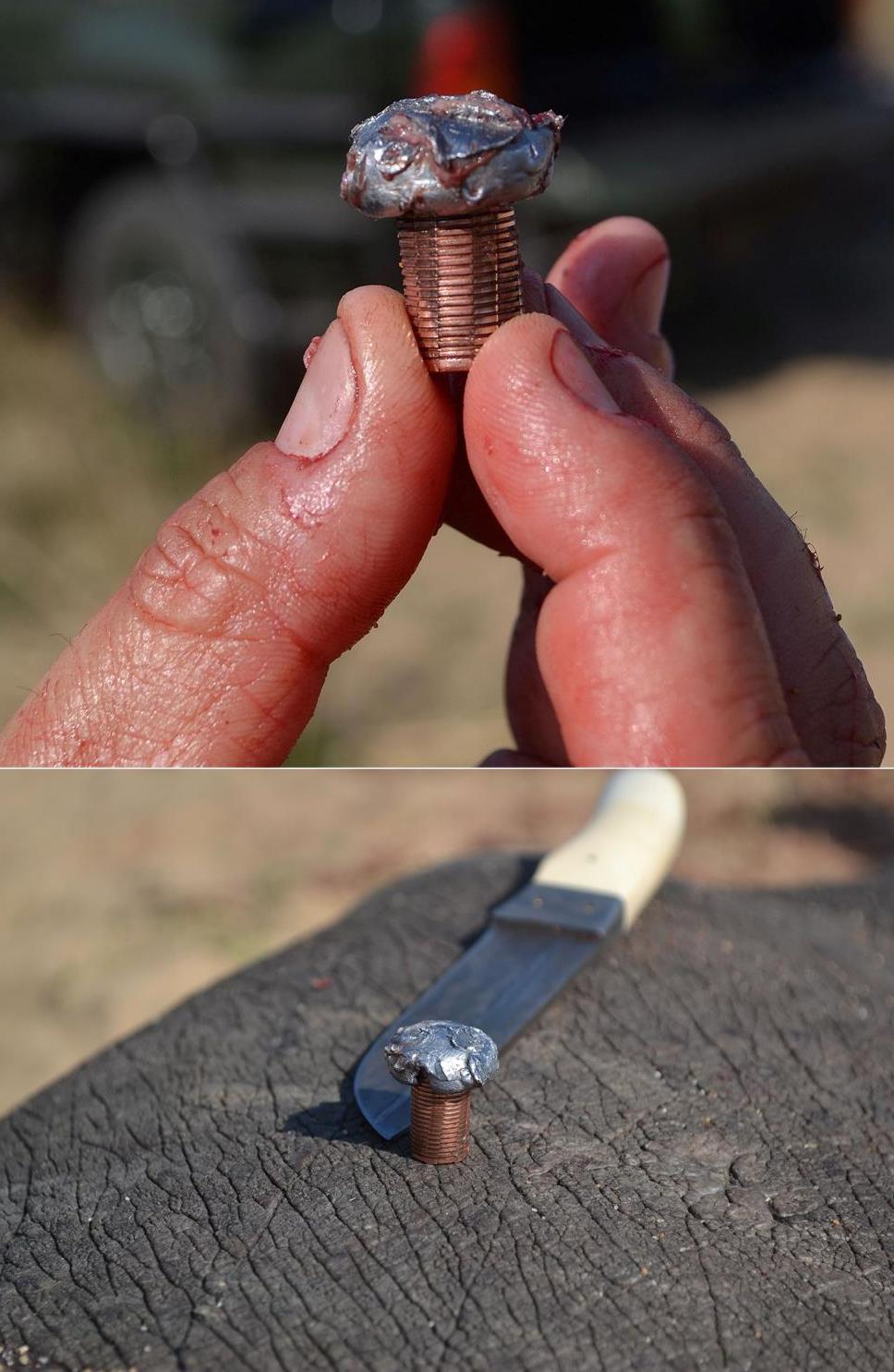
Recommended bowhunting equipment for hunting hippo
This is one animal that requires a powerful bow, a heavy arrow, and a strong, well-constructed single or two-blade broadhead. The tough, thick skin, dense muscle, and heavy bone mass is going to require every bit of kinetic energy and momentum you can transfer to your arrow.
Minimum recommendations for a bowhunter intending to shoot a hippo are a 95-100 pound draw weight bow shooting an 800-900 grain arrow delivering in the region of 100-110 foot-pounds kinetic energy, a momentum of 0.6 lbs./sec., a TPI of 50+ and velocity of about 245 feet per second. Strong 2-blade broadheads should be used. Design the arrow to have an FOC of 18% or more if possible – Figure 4. The Ashby 315-grain broadhead has proven itself on hippo and is highly recommended.

You will have to choose weapons (gun or bow) that are up to penetrating thick skin, tough muscle, and heavy bone (Figure 5). The skin can be close to 40mm thick in places and the brain is also protected by thick bone (Figure 6).
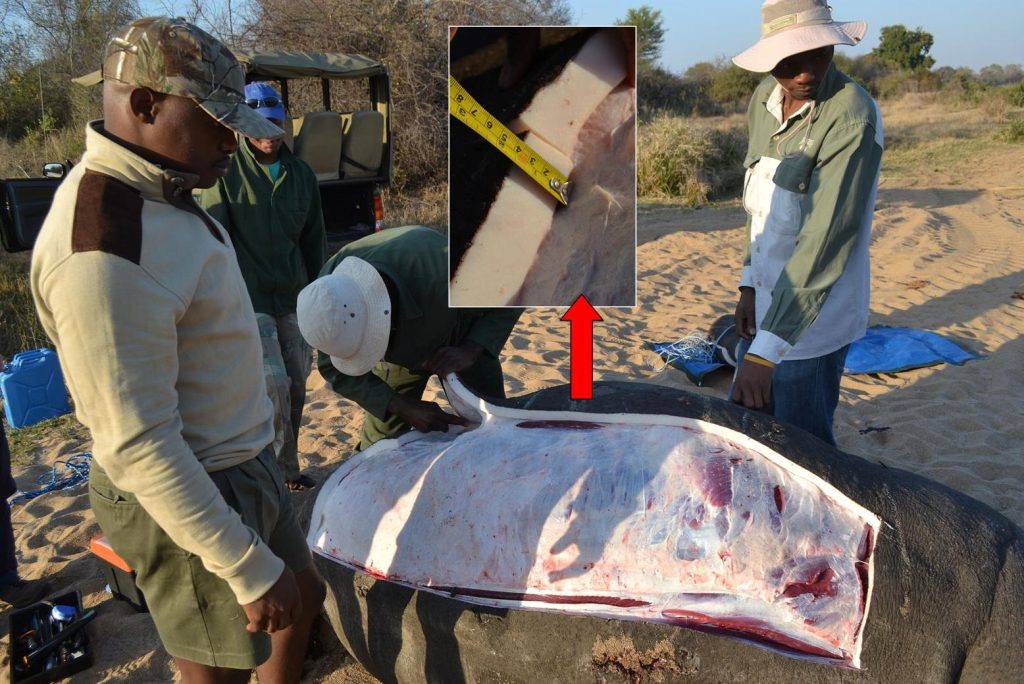

Hunting Methods
Method 1: Shooting from a concealed position when hippo are lying basking on a river bank or when they exit to feed.
If you are of the impatient sort who does not want to sit for what maybe hours in an ambush position and prefer to hunt actively, during mid-morning you can walk very quietly and stealthily along a river bank using binoculars to scan the river bank up ahead for any hippos that have left the water to sun themselves on the warm sand. You can then plan a stalk to get within range for a shot. If the hippo becomes aware of you or if they are warned by oxpeckers who are often in attendance, they will rush headlong into the water (Figure 7).
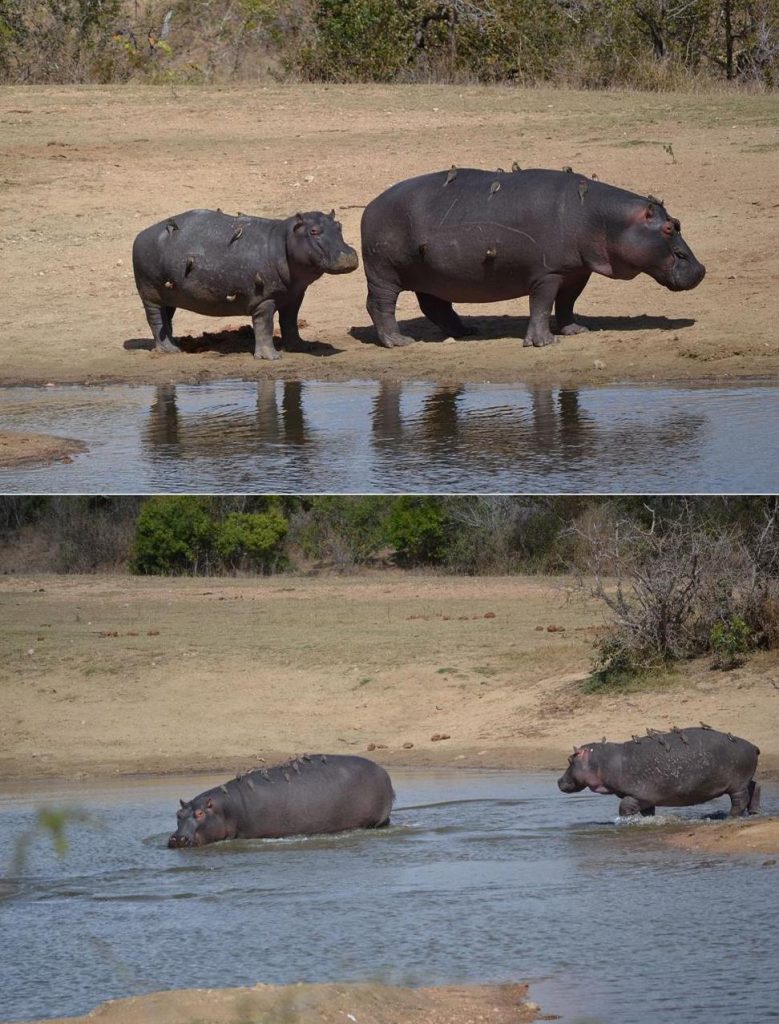
If you know of a pool where there are resident hippos, you can find yourself a nice comfortable ambush position, wait for the hippo to emerge from the water and settle down to sunbathe on the river bank, and then pick your shot. If it is a good brain shot, you will save yourself the hassle of having to haul the hippo out of the water when it expires. This can be quite an undertaking if it is in deep water.
Hippos mostly leave the water to feed at night but may also graze on grass growing close to or adjoining their pools/dams/rivers on cool, overcast days and this may also lend itself to walk and stalk or ambush options ( Figure 8).

Method 2: Shooting the hippo in the water from a concealed position on the riverbank.
With this method, you do not wait for the hippo to leave the water. If the hippo is submerged it must come up to breathe sooner or later. It can stay underwater for about five minutes before having to come up for air and this is when you will be afforded the opportunity for a brain shot. It is important you remain concealed. If the hippo is aware of your presence, it will stick its nostrils out of the water just long enough to snatch a lungful of air and will dive immediately giving you little to no time for a shot.
If however it is relaxed, it will stick the top part of its head and nostrils out of the water for quite a while before disappearing under the water again and give you time to take a well-aimed shot at the brain. The problem with a hippo brain shot in the water is that it sinks. It disappears almost immediately from sight. If it is an isolated pool this is not too much of a hassle. The reason being is that a hippo is a hindgut fermenter (the grass it eats is fermented in a huge sac called the caecum which makes up part of the large intestine) and prodigious quantities of gas are produced during the fermentation process which will soon inflate the hippo and cause it to bob to the surface within about 20 minutes or so making recovery a lot easier.
You will now have to enter the water to attach a rope or strap and use a vehicle, tractor (Figure 9), winch, or manpower to haul it out of the water. The process is a lot easier if the water is shallow (Figures 10 and 11). You will have to exercise caution if there are other hippos or crocodiles in the pool. Recovery of the dead hippo can be complicated if it is shot in a deep river where there is a current and it may be washed downstream. This may necessitate a search downstream to look for the dead animal.

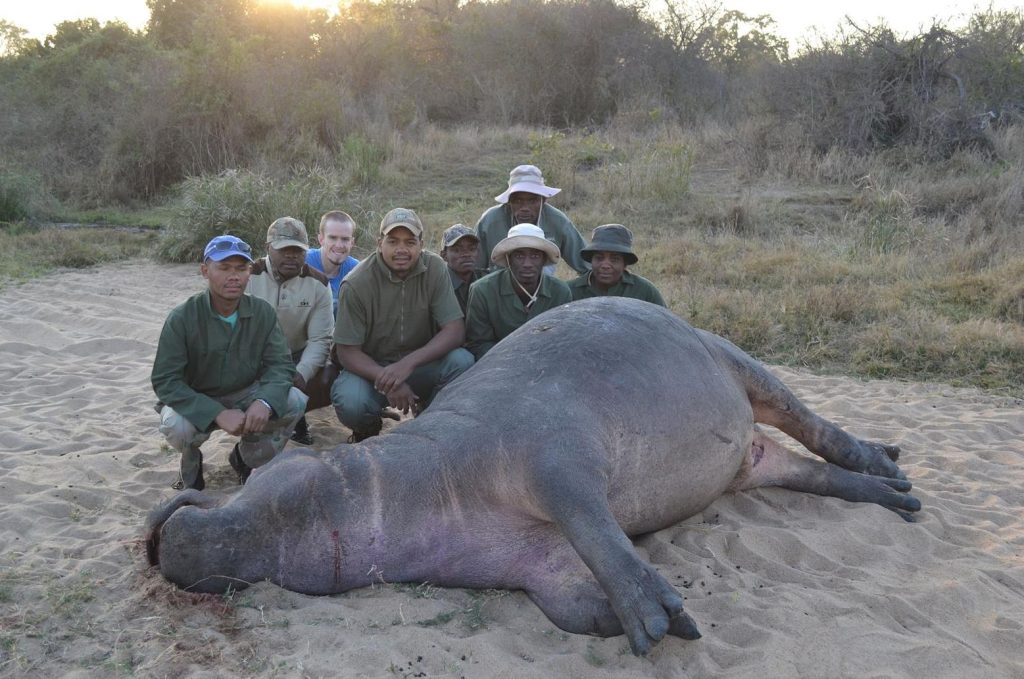

Method 3: Shooting from a boat.
This is probably the most hazardous method as you may become a target. If you are looking for thrills and spills you may end up getting both. In this method, the hunter paddles or allows the current to slowly move the boat downstream and then takes a shot at the hippo on a riverbank or in the water if and when an opportunity presents itself. It is not all that unusual for hunters using this method to be attacked by aggressive or wounded hippo. If a boat is upended and the occupants end up in the water there is a danger from both hippos and crocodiles.
Shot placement – Rifle
There are two recommended shots that can be considered when hunting hippos with a rifle. The frontal brain shot (preferred), and the side on or quartering away heart/lung shot. Anchoring shots should be considered when a hippo shot on land is making a getaway.
Frontal brain shot (Figure 12)
The brain with a relatively small cross-section of 13cm is well protected between the eye ridges by thick dense bone and is a small target to hit. The place to aim for a frontal brain shot is well defined by the hollow between the eyes and using a scope can make it a relatively straightforward shot. When a hippo is in water with only the head breaking the surface the brain is the only obvious target.
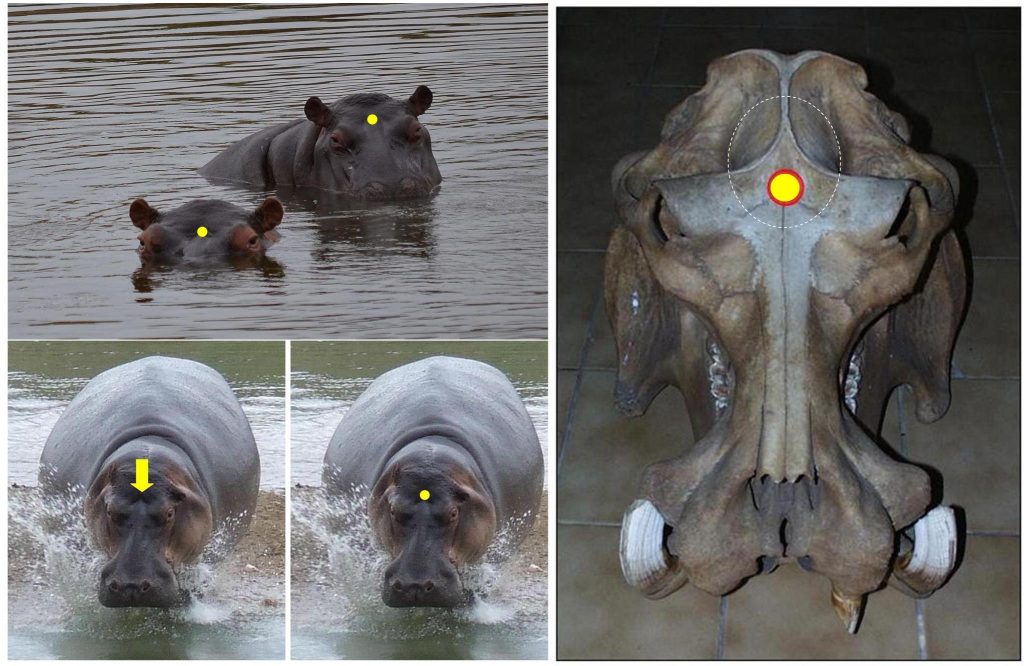
Side on heart shot (Figure 14)
The side on or quartering away heart-lung shot using a well-constructed soft or expanding solid is acceptable although it will not result in the immediate incapacitation of the animal that is most likely to head for and submerge into the closest water (if it is deep enough) or for cover.
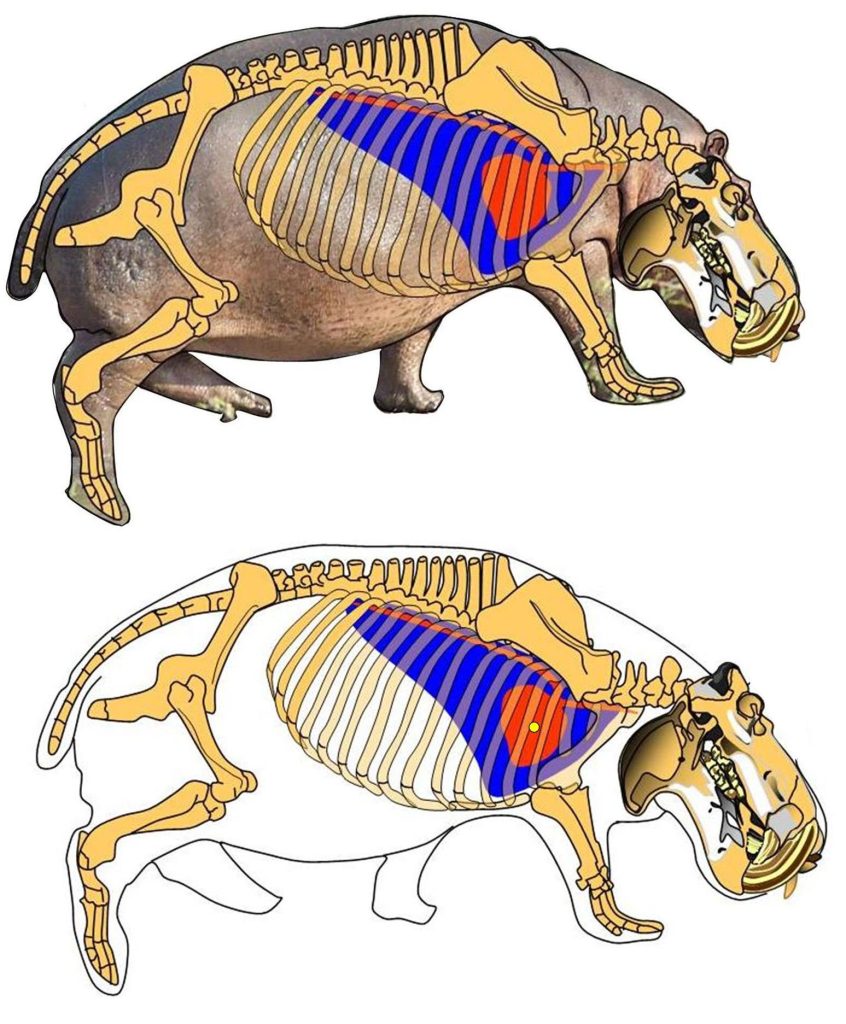
Anchoring shots (Figure 13)
If the animal is shot and wounded on land or in water too shallow to submerge a number of things may happen:
- If the hippo has seen the hunter it may charge.
- If on land it may try and run for the nearest body of water in which to escape.
- It may head off into thick bush to escape the perceived threat.
What follows will present the hunter with a variety of shots that can be taken to anchor or finally dispatch the animal. A hippo wounded on land or in very shallow water may opt to charge the hunter. If you are between a wounded hippo and its water refuge the chances are that much greater that it will run directly towards you if you are standing on its flight path. From a frontal presentation, only a brain shot will anchor or kill a hippo before it can reach you. Hippos may look big and clumsy but they can move at surprising speed (faster than what a human can run) and you may only have the opportunity to get one shot in (possibly two with a double rifle) before the angry animal reaches you and sets about causing grievous bodily harm. With the head held low frontal chest shots are also out of the question.
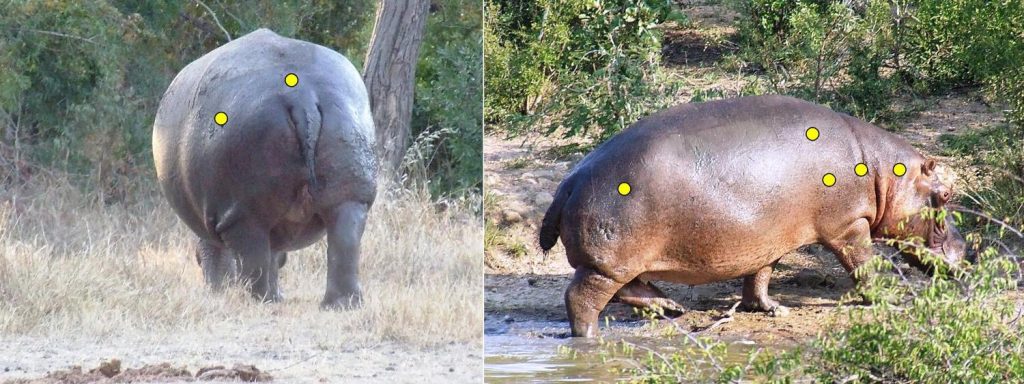
It may also happen that on being wounded, the hippo may run away presenting either a side-on or rear-end view to the hunter, but posing no immediate threat to life and limb. The best choice of shot for a lateral (side-on) presentation at a wounded hippo running off would be a high heart/lung shot. The hippo will, in all probability, not drop on the spot but will be mortally wounded and will soon expire. A spinal shot from the side, which would result in immediate incapacitation, is an option if the hippo is stationary, but is risky if the animal is running as the target is relatively small and harder to hit than the heart/lung vital area.
A third option is to break the shoulders (hence the need for a heavy solid bullet) to “anchor” the animal in place, preventing it from getting away and affording you the opportunity for follow-up shots. A strong well-constructed solid or expanding solid may also pass through the shoulder joint (junction between the scapula and femur) or scapula and hit the spine lying directly behind it with spectacular results. This shot should however not be taken in preference to a heart-lung shot but may be considered if you cannot clearly see the heart/lung area (maybe obscured by vegetation).
The most difficult shots will be presented by a hippo headed directly away from you when neither a brain nor a heart/lung shot will be realistic options. These vital organs will also be protected by the heavy bones making up the pelvic girdle. The aim in this situation is to drop the animal to prevent its escape and the base of the spine or hip joints must now be targeted, again requiring heavy, solid bullets that will not break up on contact with weighty bones such as the pelvis or femur.
Attempting to break the hip with an anchoring shot from the side or back is a dicey proposition because the well-rounded contours of a hippo’s rump make it hard to pick a spot to aim at. If the spine is hit or a hip broken the animal will be slowed enough to afford the hunter additional and hopefully, immediately fatal shots taken from a suitable position to put an end to the beast’s suffering.
Shot placement (Bow)
There is only one acceptable shot for a hippo with a bow and that is a side-on heart-lung shot (Figure 14). Even this shot is demanding of archery equipment. The shot will also have to be taken at reasonably close range (30m or so) and is going to put the archer at risk. A suitably armed professional hunter should be close at hand.
Following up on wounded hippo
Opinions differ – based on different experiences but be advised a wounded hippo on land is a formidable opponent. Keep in mind that they are one of the most aggressive herbivores, accounting for more human deaths each year than all other members of the Big Five combined.
They can absorb almost the same amount of punishment from misplaced lead as that of a cornered or wounded buffalo and should be treated with a healthy dose of respect. Open sights are strongly advised during a follow-up as it may be difficult to quickly acquire your target through a scope in an emergency. There are a number of bullet types (expanding and solid) that can be considered for hunting hippos but, when it comes to follow-up of a wounded individual, only solids should be used.
Trophy measurement and current records
The largest trophy is not necessarily found in the oldest hippo as tusks are inclined to wear after reaching 20 years. They make very impressive shoulder mounts.
Rowland Ward method: The minimum score for inclusion in RW records is 29 7/8” with the record being 64 ½ “. The method of measurement is shown in Figure 15.
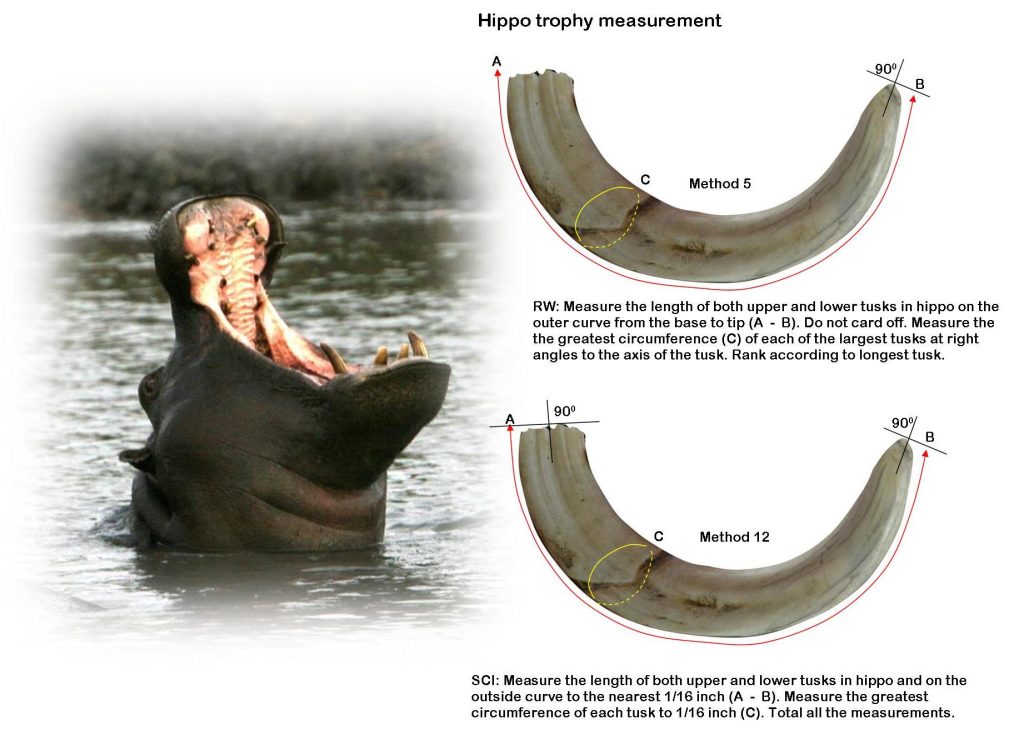
SCI method: Minimum score for inclusion in SCI records is 50 (rifle) and 45 for an animal killed with a bow and arrow. The method of measurement is shown in Figure 15.
REFERENCES
Cheney, C.S. (2013) The Comprehensive Guide to Tracking – Safari Press
Mellon, L. (1975) African Hunter –Harcourt Brace Jovanovich New York and London
Robertson, K. (1999) The Perfect Shot – Safari Press
Robertson, K (2007) Africa’s Most Dangerous – Safari press

